
Dictyoptera is an insect superorder that includes two extant orders of polyneopterous insects: the order Blattodea and the order Mantodea (mantises). While all modern Dictyoptera have short ovipositors, the oldest fossils of Dictyoptera have long ovipositors, much like members of the Orthoptera.

Blattidae is a cockroach family in the order Blattodea containing several of the most common household cockroaches. Some notable species include:
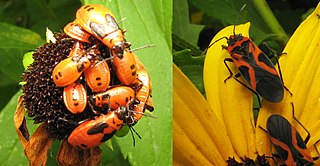
Hemimetabolism or hemimetaboly, also called incomplete metamorphosis and paurometabolism, is the mode of development of certain insects that includes three distinct stages: the egg, nymph, and the adult stage, or imago. These groups go through gradual changes; there is no pupal stage. The nymph often has a thin exoskeleton and resembles the adult stage but lacks wings and functional reproductive organs. The hemimetabolous insects differ from ametabolous taxa in that the one and only adult instar undergoes no further moulting.
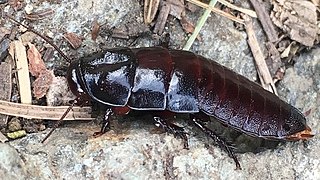
Cryptocercus is a genus of Dictyoptera and the sole member of its own family Cryptocercidae. Species are known as wood roaches or brown-hooded cockroaches. These roaches are subsocial, their young requiring considerable parental interaction. They also share wood-digesting gut bacteria types with wood-eating termites, and are therefore seen as evidence of a close genetic relationship, that termites are essentially evolved from social cockroaches.

Corydiidae, previously known as Polyphagidae, is a family of the order Blattodea (cockroaches). Many are known as sand cockroaches. The family is divided into five subfamilies, comprising some 40 genera. One prominent species is the desert cockroach, Arenivaga investigata.
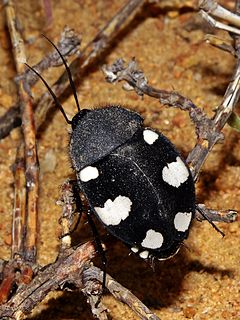
Blattodea is an order of insects that contains cockroaches and termites. Formerly, the termites were considered a separate order, Isoptera, but genetic and molecular evidence suggests termites evolved from within the cockroach lineage, cladistically making them cockroaches as well. The Blattodea and the mantises are now all considered part of the superorder Dictyoptera. Blattodea includes approximately 4,400 species of cockroach in almost 500 genera, and about 3,000 species of termite in around 300 genera.

Cockroaches are a paraphyletic group of insects belonging to Blattodea, containing all members of the group except termites. About 30 cockroach species out of 4,600 are associated with human habitats. Some species are well-known as pests.
Blattoptera, or proto-cockroaches, is a name given to various "roachoid" fossil insects related to cockroaches, termites and mantises, and of general cockroach-like appearance and possibly habit. The group is on the rank of an order, though being paraphyletic is most often given without formal taxonomic rank. Several alternative names have been suggested for this fossil group, including Blattodea, a name currently used for the group including the modern cockroaches as well as their fossil relatives.

The Tryonicidae are a family of cockroaches.

Cephidae is a family of stem sawflies in the order Hymenoptera. There are about 27 genera and more than 160 described species in Cephidae.

Corydioidea is a superfamily of insects in the order Blattodea, the cockroaches and termites. It contains two extant families, Corydiidae and Nocticolidae, comprising about fifty genera and two hundred and fifty species, along with the extinct family Liberiblattinidae. Members of this superfamily are found worldwide, mostly in hot, arid habitats.
This taxonomy of the Dermaptera follows Engel & Haas (2007) to the rank of Tribe.
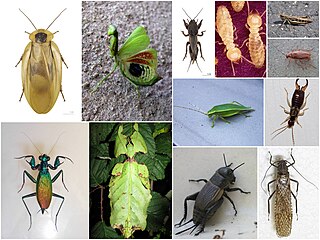
The cohort Polyneoptera is a proposed taxonomic ranking for the Orthoptera and all other Neopteran insects believed to be more closely related to Orthoptera than to any other insect orders. These winged insects, now in the Paraneoptera, were formerly grouped as the Hemimetabola or Exopterygota on the grounds that they have no metamorphosis, the wings gradually developing externally throughout the nymphal stages.

Archotermopsidae is a family of termites in the order Blattodea, known as dampwood termites, formerly included within the family Termopsidae. They constitute a small and rather primitive family with five extant genera and 13–20 living species. They may be a nuisance, but compared to the drywood termites (Kalotermitidae), usually do not cause extensive damage to buildings or other man-made structures. As their name implies, they eat wood that is not dried out, perhaps even rotting, and consequently of little use to humans.
Tenuirostritermes is a genus of termites in the family Termitidae. There are about five described species in Tenuirostritermes.

Stolotermitidae is a family of termites in the order Blattodea, with two extant genera formerly placed in the family Termopsidae. There are about 14 described species in Stolotermitidae.

Stylotermitidae is a family of termites in the order Blattodea. There are two extinct and one extant genera in Stylotermitidae, with more than 50 described species.
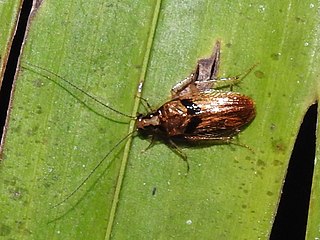
Anaplectidae is a family of cockroaches in the order Blattodea. Previously placed as a subfamily of the Ectobiidae there are presently (2020) two genera and more than 90 described species in Anaplectidae.















